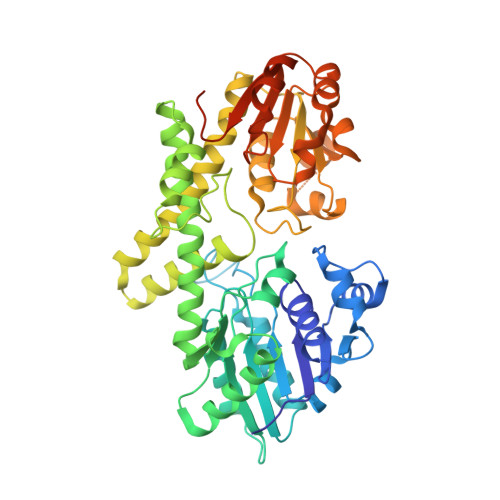Role of Packing Defects in the Evolution of Allostery and Induced Fit in Human UDP-Glucose Dehydrogenase.
Kadirvelraj, R., Sennett, N.C., Polizzi, S.J., Weitzel, S., Wood, Z.A.(2011) Biochemistry 50: 5780-5789
- PubMed: 21595445
- DOI: https://doi.org/10.1021/bi2005637
- Primary Citation of Related Structures:
3PRJ, 3PTZ - PubMed Abstract:
Allosteric feedback inhibition is the mechanism by which metabolic end products regulate their own biosynthesis by binding to an upstream enzyme. Despite its importance in controlling metabolism, there are relatively few allosteric mechanisms understood in detail. This is because allostery does not have an identifiable structural motif, making the discovery of new allosteric enzymes a difficult process. The lack of a conserved motif implies that the evolution of each allosteric mechanism is unique. Here we describe an atypical allosteric mechanism in human UDP-α-d-glucose 6-dehydrogenase (hUGDH) based on an easily acquired and identifiable structural attribute: packing defects in the protein core. In contrast to classic allostery, the active and allosteric sites in hUGDH are present as a single, bifunctional site. Using two new crystal structures, we show that binding of the feedback inhibitor, UDP-α-d-xylose, elicits a distinct induced-fit response; a buried loop translates ∼4 Å along and rotates ∼180° about the main chain axis, requiring surrounding side chains to repack. This allosteric transition is facilitated by packing defects, which negate the steric conformational restraints normally imposed by the protein core. Sedimentation velocity studies show that this repacking favors the formation of an inactive hexameric complex with unusual symmetry. We present evidence that hUGDH and the unrelated enzyme dCTP deaminase have converged to very similar atypical allosteric mechanisms using the same adaptive strategy, the selection for packing defects. Thus, the selection for packing defects is a robust mechanism for the evolution of allostery and induced fit.
- Department of Biochemistry and Molecular Biology, University of Georgia, Athens, Georgia 30602, USA.
Organizational Affiliation:


















